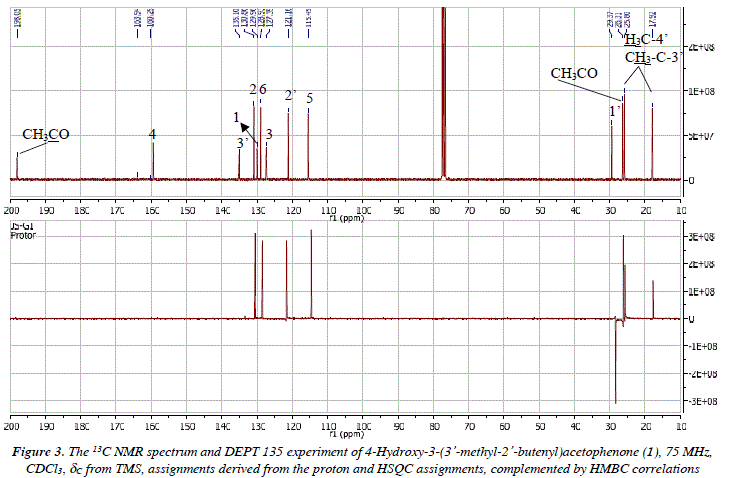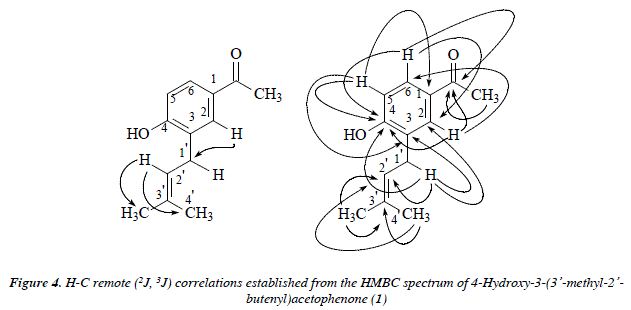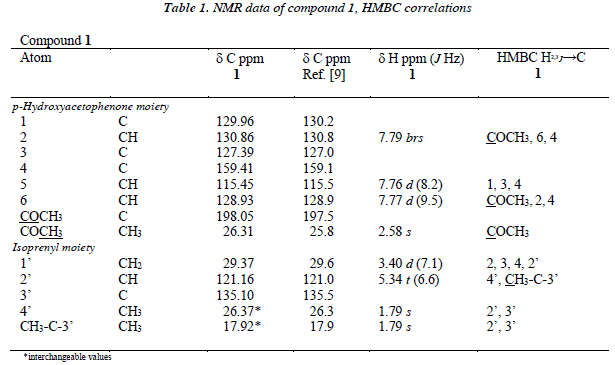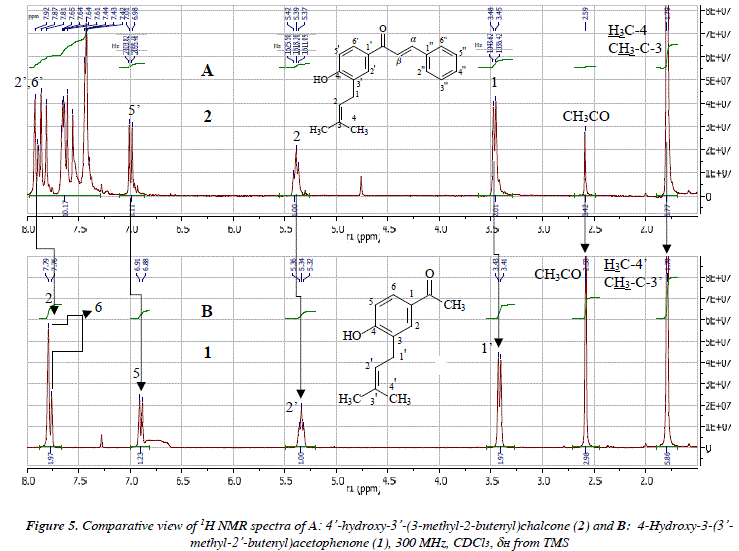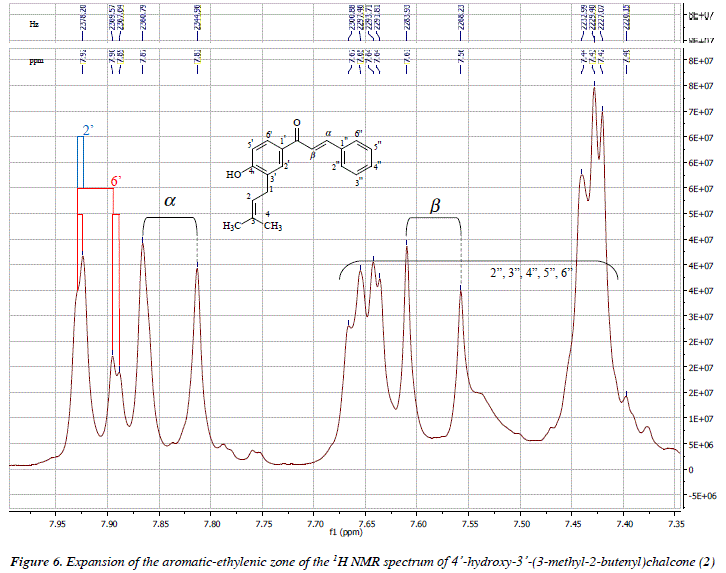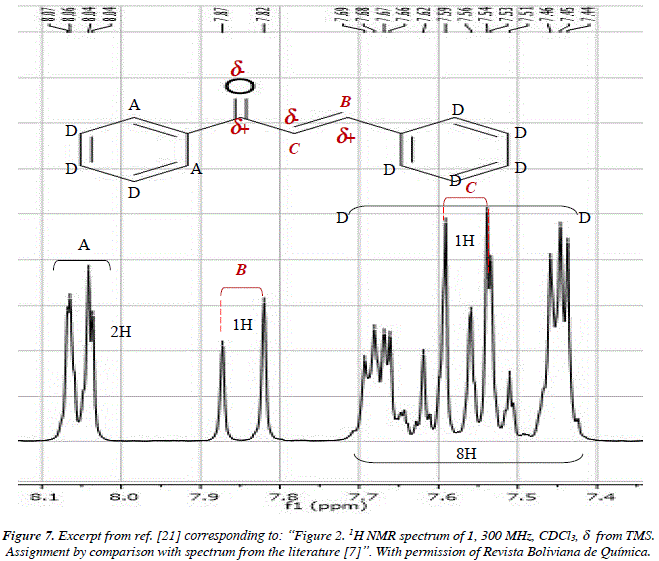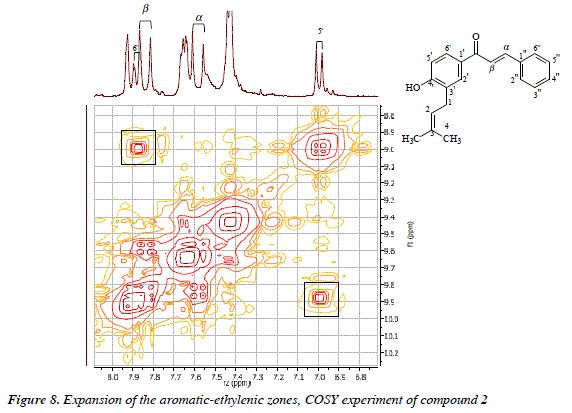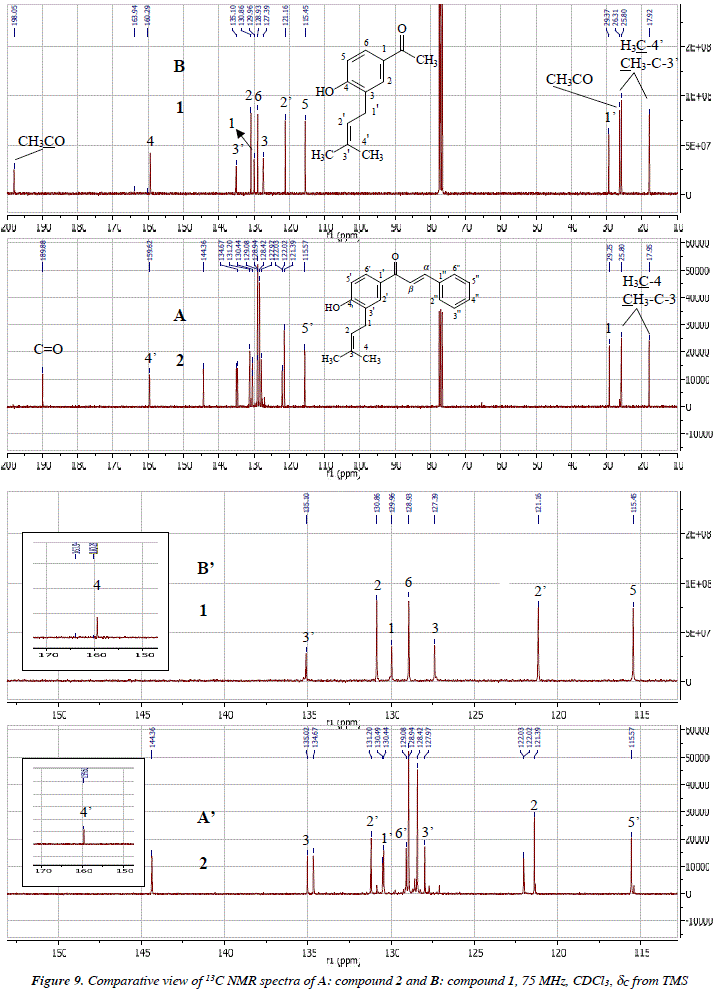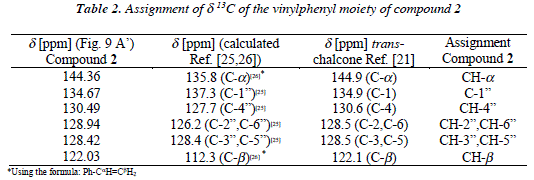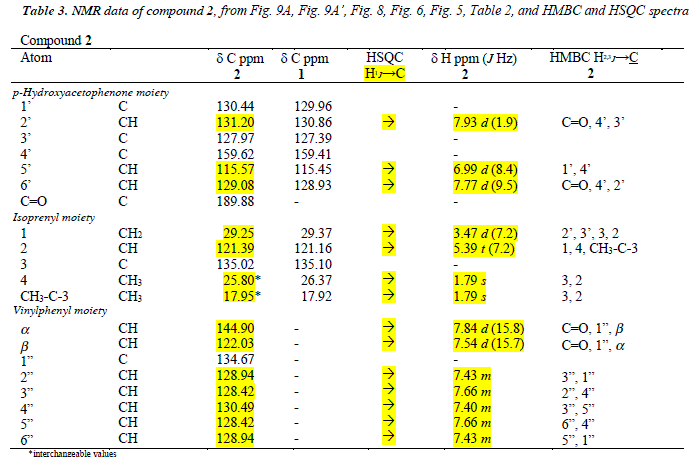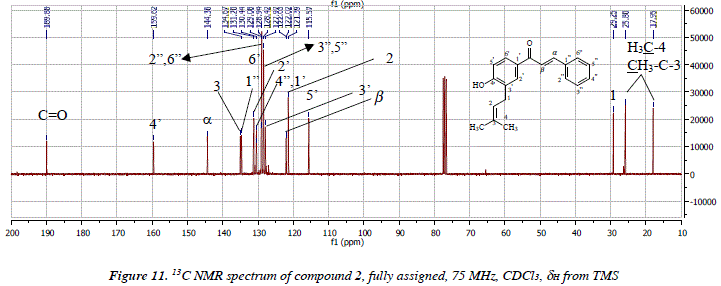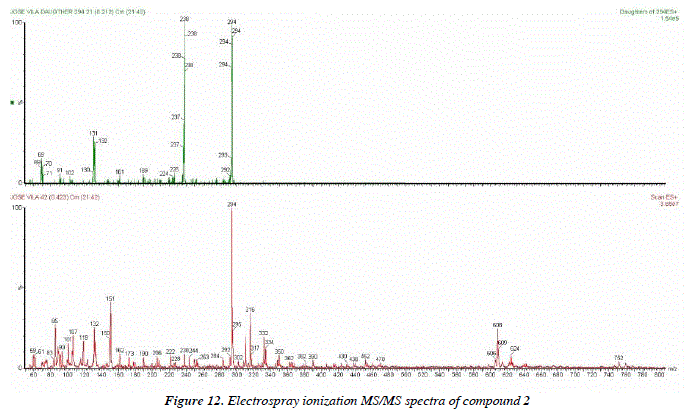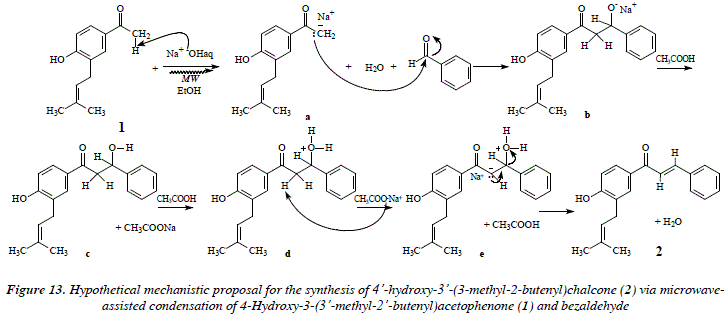Services on Demand
Journal
Article
Indicators
-
 Cited by SciELO
Cited by SciELO -
 Access statistics
Access statistics
Related links
-
 Similars in
SciELO
Similars in
SciELO  uBio
uBio
Share
Revista Boliviana de Química
On-line version ISSN 0250-5460
Rev. Bol. Quim vol.34 no.3 La Paz 2017
ARTÍCULOS ORIGINALES
Synthesis of the new 4-hydroxy-3-(3-methyl-2-butenyl)chalcone
by microwave-assisted condensation of 4-hydroxy-3-(3-methyl-2-butenyl)
acetophenone isolated from senecio graveolens and benzaldehyde
Síntesis de la nueva 4-hidroxi-3-(3-metil-2-butenil)chalcona
por condesación asistida por microondas de 4-hidroxi-3-(3-metil-2-butenil) acetofenona aislada a partir de senecio graveolens y benzaldehido
Gabriela Ibieta Jiménez1, José A. Bravo2, Yovana Quispe Coro3,
Oscar Solís3, José L. Vila1,*
1Natural Product Laboratory, Green Chemistry, Chemical Sciences Department, School of Pure and Natural Science FCPN,
Universidad Mayor de San Andrés UMSA, P.O. Box 303, Calle Andrés Bello s/n, Ciudad Universitaria Cota Cota,
phone +59122772269, La Paz, Bolivia, jlvila@umsa.bo, www.umsa.bo
2Natural Product Laboratory, Phytochemistry, Chemical Sciences Department., School of Pure and Natural Science FCPN,
Universidad Mayor de San Andrés UMSA, P.O. Box 303, Calle Andrés Bello s/n, Ciudad Universitaria Cota Cota,
phone +59122792238, La Paz, Bolivia, jabravo@umsa.bo, www.umsa.bo
3Carrera de Química, Facultad de Ciencias Puras FCP, Universidad Autónoma Tomás Frías UATF, P.O. Box 36,
Avenida del Maestro s/n, phones +591226227300, +591226223280, fax +591226226663, Potosí, Bolivia,
quimicauatf@hotmail.com, quimica@uatf.edu.bo, www.uatf.edu.bo
*Corresponding author: joselu62@hotmail.com
Received 08 06 2017 Accepted 08 29 2017 Published 08 30 2017
ABSTRACT
In this article we report the synthesis of a new chalcone, 4-hydroxy-3-(3-methyl-2-butenyl)chalcone 2, from the organic condensation assisted by microwave irradiation of benzaldehyde and 4-hydroxy-3-(3-methyl-2-butenyl)acetophenone 1, the latter isolated from Senecio graveolens. Compound 2, being of synthetic origin has not been so far isolated from natural sources. Structures were established by modern NMR techniques.
Keywords: 4-Hydroxy-3-(3-methyl-2-butenyl)acetophenone, Benzaldehyde,4’-hydroxy-3’-(3-methyl-2-butenyl)chalcone, Microwave-assisted Synthesis, Irradiation, Green Chemistry, NMR, Senecio graveolens, Asteraceae.
RESUMEN
En el presente artículo reportamos la síntesis de una nueva chalcona, 4-hidroxi-3-(3-metil-2-butenil)chalcona 2, vía condensación orgánica asistida por irradiación de microondas de benzaldehído y 4-hidroxi-3-(3-metil-2-butenil)acetofenona 1, aislada de la especie vegetal Senecio graveolens. El compuesto 2, que es de origen sintético, no se ha aislado hasta ahora de fuentes naturales. Las estructuras fueron establecidas por técnicas modernas de RMN.
INTRODUCTION
The species Senecio graveolens, Wedd. Asteraceae (quechua vernacular name: Chachacoma) is commonly used as traditional medicine remedy in the western highlands region of Bolivia, specially the Potosi department [1]. Medical indications of the fresh leaves aqueous hot infusion include stomachache, digestive relief like intestinal ache and flatulence; also the fresh leaves aqueous decoction is indicated for the treatment of anomalies of the menstrual cycle like white vaginal discharge and ovaries disorders (emmenagogue) [1]. A specimen collected in La Paz Department was deposited at the Muséum dHistoire Naturelle de Paris [2]. Previous research on the species afforded essential oil components: isovaleraldehyde, α-pinene, α-phellandrene, α-terpinene, p-cymene, sabinene, γ-terpinene, 1-methyl-4-isopropenylbenzene, terpinolene, terpinen-4-ol, piperitenone, α-eudesmol and β-eudesmol; the antibacterial indexes of the essential oil over Micrococcus luteus and oxacillin-sensitive and oxacillin-resistant Staphylococcus aureus, and the atifungal activity over clinically isolated Candida albicans was established by these authors [3]. Another report on essential oils content mentions the characterization of sabinene, (+)-4-carene, t-terpinene, b-myrcene, 4-terpinenol and pulegone; the corresponding biological activity assays showed a strong activity against Gram (+) Staphylococcus aureus ATCC 29923 and a moderate activity against Gram (-) Escherichia coli [4]. Also, dihydroeuparin, 4-hydroxy-3-(isopenten-2-yl)acetophenone, 3-hydroxy-2,2-dimethyl-6-acetylchromane, 5-acetylsalicylaldehyde and 4-hydroxy-3(3'-hydroxyisopentyl)acetophenone were found in the aerial parts of the plant [5]. 4-hydroxy-3-(3-methyl-2-butenyl)acetophenone 1, was found to be the major component of the alcoholic extract of the whole plant, and was assayed separately and as part of the alcoholic extract against breast cancer cell lines ZR-75-1, MCF-7 and MDA-MB‑231, and non-tumorigenic MCF-10F cells: the alcoholic extract showed anticancer activity displaying a specific cytotoxic effect on cancer cells but compound 1 alone, didn´t [6]. The plant is used in the highlands of Chile [6], Bolivia [7] and Peru and Argentina [8] against altitude hypoxia. A metabolomic altitudinal profiling study was done on samples collected between 4116 to 4611 masl in the XVth region of Chile; 2-hydroxy-5-(3-methylbut-2-enyl)acetophenone (3) besides compound 1, 4-hydroxy-3-(3-methyl-2-butenyl)acetophenone were isolated and identified in the aerial parts of the plant [8]. The results showed differences in the chemical composition of Senecio graveolens growing at different altitudes and cytotoxic activity on MCF-7 cells (IC50 139 µM) but no antibacterial properties for compound 3 [8]. The specific Gram-positive antibacterial activity of compound 1 isolated from Senecio graveolens, was established for methicillin-resistant strains of Staphylococcus aureus and Mycobacterium smegmatis, the compound was inactive against Gram-negative bacteria [9]. The permeabilizing effect of compound 1 on bacterias membrane to avoid cell division was proposed by the authors [9]. Senecio graveolens was also the source of dihydroeuparin which was employed to afford synthetic oxime-derivatives of dihydroeuparin [10]. The aqueous 70% ethanol extract of leaves of Senecio graveolens collected in Bolivia´s highlands at its lowest concentration produced a 12 mm inhibition halo in Petri dish on strains of Staphylococcus aureus [11]. Scopoletin was isolated from Senecio nutans and the phytochemical extract evaluated with respect to its antioxidant properties by ABTS and FRAP methods [12].
The condensation reported in the present article uses 4-Hydroxy-3-(3-methyl-2-butenyl)acetophenone (1) and benzaldehyde as precursors. 4-Hydroxy-3-(3-methyl-2-butenyl)acetophenone was previously isolated from Senecio graveolens and its antifungal properties were evaluated and defined regarding the mode of action, particularly against Candida albicans (strain ATCC 10231) [13,14]. Compound 1 is present as well in other plants like Smallanthus sonchifolia (Yacon) for instance [15]. Compound 1, determined in Helychrisum species, was found to be active against Gram negative Escherichia coli and fungi like: Penicillium sp., Cladosporium herbarum and Phytophtora capsicii; it was found inactive against Aspergillus species at a MIC of 100 mg/mL [16], its full structure was established by conventional spectroscopic methods and by X-ray analyses [17]. Compound 1, which is the major component of Helichrysum italicum was assayed and qualified as an inhibitor of leukotriene B4 production at 100 mM with a 95% inhibition (IC50 24 mM) [18-20].
In this article we described the isolation of compound 1 from the aerial parts of Senecio graveolens whose chemical structure was established by us by the using of modern NMR techniques and the analysis of the corresponding spectra. Compound 1 was used in the organic condensation (green chem conditions) with benzaldehyde to afford the new: 4-hydroxy-3-(3-methyl-2-butenyl)chalcone 2. As known, green chem conditions imply a number of advantages regarding classical synthetic methods, namely, cheap irradiation equipment, low temperatures, short irradiation times, short reaction times, access to energy control, potential better yields, eventual stereochemical specificity, environmental friendly solvents, etc. The present article is part of the further work we intend to develop in the field of MAOS (Microwave Assisted Organic Synthesis) [21].
RESULTS AND DISCUSSION
Microwave-assisted condensation synthesis of compound 2
The condensation reaction of 1 with benzaldehyde employed an alkaline medium (10% aqueous NaOH + 2 mL EtOH). After 10 minutes of irradiation, 98.8% aqueous AcOHglacial was added to the reaction mixture which collapsed into two phases subsequently separated in a separation funnel. The organic layer was extracted against water many times. Once evaporated the solvent of the organic layer a yellowish solid was submitted to an open LC column to afford the new 4-hydroxy-3-(3-methyl-2-butenyl)chalcone 2 whose structure was elucidated by NMR. Green synthesis of chalcones obey to the Claisen-Schmidt condensation which is easily attained with good yields depending on the nature of the reagents and desired products [21-23]. See Figure 1.
Structural elucidation of 4-Hydroxy-3-(3-methyl-2-butenyl)acetophenone (1) isolated from the aerial parts of Senecio graveolens
Figure 2 shows the 1H NMR full spectrum of 1. Five spectral zones are distinguishable (all ciphers in ppm): 7.9-7.7 aromatics, alkenic, 7.0-6.8 aromatics, alkenic, 5.5-5.3 alkenic, 3.5-3.3, allyl, benzyl, 2.6-2.2, acetyl, and 1.8-1.7, allylic methyls. Assignments can be done a priori (see Figure 2). The integral value of the singlet of the two isolated and chemically equivalent methyl groups of isoprenyl is 5.86 for 6 protons δ 1.79 (s, 6H, CH3-C-3, H3C-4). The next signal toward downfield is a singlet integrated as 2.94 for 3 acetyl protons δ 2.58 (s, 3H, CH3CO). Next peak integrated as 1.94 for 2 protons is the doublet for the allylic methylene equivalent protons of the isoprenyl group δ 3.40 (d, 2H, J 7.1 Hz, H-1). Toward downfield we find the olefinic proton triplet of the isoprenyl group whose integral value is 1.00 for one proton δ 5.34 (t, 1H, J 6.6 Hz, H-2). By rounding ciphers we find that protons 2 and 1 share the same coupling constant, namely J 7 Hz. We have assigned 12 protons so far, namely all protons of the benzene ring substituents (acetyl and isoprenyl, the hydroxyl proton is not visible in the proton spectrum). The signals of the three aromatic protons appear at down field: a doublet integrating as 1.22 or one proton δ 7.76 (d, 1H, J 8.2 Hz, H-5), and the doublet that integrates as 1.98 for two protons; first proton at δ 7.77 (d, 1H, J 9.5 Hz, H-6) and the second proton at δ 7.79 (brs, 1H, J indistinguishable, H-2). Obviously, the aromatic protons J-ortho coupling H-5/H-6 is defined by their proximate J values (8 and 9 Hz, respectively). The J-meta coupling between H-6 and H-2 is indistinguishable and it probably is less than 1 Hz. The full structural determination done a posteriori was achieved by the employ of 2DNMR experiments. The COSY experiment confirmed the 1H NMR spectrum assignments (Figure 2). To the proton spectrum assignment (Figure 2) followed the carbon spectrum assignment (Figure 3) by means of the use of the proton assignments and the HSQC spectrum. These permitted the assignment of all hydrogenated carbons. For the assignment of the quaternaries we used the HMBC spectrum. The assignments written for the quaternaries in the carbon spectrum of Figure 3, namely C-3, C-1, C-3, C-4 and C=O, were deduced from correlations unequivocally established in the HMBC spectrum. The HMBC guided us thus to the establishment of the benzene ring correct substitution pattern as shown in Figure 2 or 4-Hydroxy-3-(3-methyl-2-butenyl)acetophenone (1). Figure 4 shows the H-C remote (2,3JH→C) correlations established from the HMBC spectrum.
Table 1 shows the NMR data for compound 1. These data are congruent with those published for compound 1 in the literature [9,24].
Structural elucidation of 4-hydroxy-3-(3-methyl-2-butenyl)chalcone (2)
Figure 5 A and B is a comparative view of the 1HNMR spectra of compounds 2 and 1 respectively. This picture provides the spectral tool for the direct assignment of the p-hydroxyacetophenone and isoprenyl moieties of compound 2 thanks to the direct comparison of signals in both spectra (see partially assigned proton spectrum of 2 [Figure 5 A]). This means that protons H-5, H-2, H-1, CH3CO, H3C-4 and CH3-C-3 in Fig. 5 A can be directly assigned by simple comparison with the corresponding signals in the proton spectrum of 1 (Fig. 5 B). Moreover, from Figure 5 A its deducible that the signal cluster in the range δ 8.00-7.25, includes the aromatic protons H-2 and H-6 of compound 2 (homologable to the aromatic protons H-2 and H-6 in compound 1, Fig. 5 B). In this sense, its possible a priori, on the basis of the similar shape of both signals, to assign the last three stripes at the left extreme of spectrum in Fig. 5 A to protons H-6 (δ 7.92, 7.90 and 7.89) and H-2 (δ 7.92) in 2. Let us signal at this point that the assignment of H-6 (δ 7.90 and 7.89) and H-2 (δ 7.92) in 2 (Fig. 5 A) can be backed because there is a progressive shift toward low field of the proton signals of 2 (Fig. 5 A) with respect to those of 1 (Fig. 5 B) starting at δ 2.59 as follows: δ 2.58 (1)→δ 2.59 (2), δ 3.41 (1)→δ 3.45 (2), δ 3.43 (1)→δ 3.48 (2), δ 5.32 (1)→δ 5.37 (2), δ 5.34 (1)→δ 5.39 (2), δ 5.36 (1)→δ 5.42 (2), δ 6.88 (1)→δ 6.98 (2), δ 6.91 (1)→δ 7.01 (2), δ 7.76 (1)→δ 7.89 and 7.90 (2), and δ 7.79 (1)→δ 7.92 (2). Let us mention that the signal at δ 2.59 (2), is in reality the acetyl function of the acetophenone 1, which remained in the mixture unreacted, or as a pollutant of the final product, the chalcone 2; Figure 5 (2) proves this hypothesis since the integral value at δ 2.59 (2) is only half one proton with respect to the δ 2.58 (1) whose integral corresponds to 3 protons. The rest of integrals in 2 are congruent with the structure. Signals between δ 7.87 and δ 7.40 (Figure 6), should include the resonances for the aromatic protons 1-6 and the α,β-ethylenic system (see the expansion of this zone in Figure 6).
The expansion (Fig. 6) allows now to establish the meta coupling for H-6→H-2 in chalcone 2 by the measuring of J in Figure 6. The measured values are: 3J6→5 = 10.56 Hz and 4J6→2 = 1.93 Hz, both values are between the acceptable ranges for vicinal and long range proton couplings respectively in aromatic rings. For the characterization of the ethylenic system and the monosubstituted benzene ring of compound 2 it resulted very useful the employ of a bibliographic reference [21] and references therein, where a similar compound (benzylideneacetophenone or trans-chalcone) was structurally described, from where we extracted the 1H NMR spectrum (Figure 7, excerpt authorized by Bolivian Journal of Chemistry), punctually, the expansion of the aromatic and ethylenic systems. Figure 7 here, corresponds to Figure 2 in reference [21]. The ethylenic system appears in Fig. 7 as proton B with stripes at δ 7.87 and 7.82, and proton C with stripes at δ 7.59 and 7.53. Their respective equivalences in Fig 6 (Compound 2) are: proton β with stripes δ 7.87 and 7.81, and proton a, stripes δ 7.61 and 7.56. The coupling constant 3Ja→β = 15.8 Hz is congruent with a trans coupling. The five aromatic protons of the vinyl-phenyl moiety of the trans-chalcone [21] (signaled as protons D in Fig. 7) are described there mostly by the four stripes:δ 7.69, 7.68, 7.67 and 7.66 and the three stripes: δ 7.46, 7.45 and 7.44. The corresponding signals in Fig. 6 (compound 2) are: the four stripes δ 7.67, 7.65, 7.64 and 7.64, and the three stripes: δ 7.44, 7.43 and 7.42. These aromatic signals are not analyzable with regard to their coupling constants.
The last correlations between Fig. 6 and Fig. 7 are the remotely coupled aromatic protons 6 and 2 in compound 2 with stripes δ 7.92, 7.90 and 7.89, whose corresponding stripes in Fig. 7 are δ 8.07, 8.06, 8.04 and 8.04 designated as protons A. The difference between the chemical shifts of protons A (Fig. 7) and protons 6 and 2 (Fig. 6) like for instance 8.06Fig.7 - 7.90Fig.6 = 0.16 ppm lies on the structural difference between them, namely the isoprenyl substituent in compound 2 (Fig. 6), absent in the trans-chalcone. This 1H NMR comparative analysis proves by itself the identity of compound 2 as 4-hydroxy-3-(3-methyl-2-butenyl)chalcone. See Table 3 for the NMR data of 2.
We have performed 2D NMR experiments with compound 2. The COSY experiment clearly shows correlation peaks for vicinal (3J), and some remote couplings (4J). In the isoprenyl moiety: H-23JHH→H-1 and H-24JHH→H3C-4, H-24JHH→HC3-C-3. In the p-hydroxyacetophenone moiety: H-63JHH→H-5 and H-64JHH→H-2'. In the vinylphenyl moiety: H-α3JHH→H-b. The COSY expansion (Figure 8) shows a discrepancy with respect to the proton analysis based on Fig. 5, 6 and 7 regarding the coupling between H6 and H-2. The 2D experiment shows with this respect a pair of symmetrically disposed crosspeaks connecting H-5 with H-6, the latter being described in the horizontal proton projection of COSY with stripes at δ 7.90, 7.89 and 7.87 instead of δ 7.92, 7.90 and 7.89 as assigned in Figure 6. However, the comparative analysis of the 1H NMR spectra of compound 2 and trans-chalcone [21] affirms the results deduced from the 1D analysis purely. Figure 9 is a comparative view (and its expansions) of the 13C NMR spectra of 2 and 1. This comparison allowed the assignment of the corresponding carbon signals in 2 (see Table 3), complemented by the employ of the HSQC spectrum (see Table 3). Figure 9 shows that all carbons corresponding to the moiety derived from the precursor 4-hydroxy-3-(3-methyl-2-butenyl)acetophenone (1) currently condensed with benzaldehyde under the form of compound 2, can be directly assigned in 2 by examination of both spectra (comp. 1 and 2). The assignment was done, indeed, by the close similarity of their chemical shift values (see Table 3). In Fig. 9 A there remain 6 signals not assigned yet. From these, two correspond to alkenic carbons (α and β) and four to aromatic signals for the six aromatic carbons of the mono substituted benzene ring of compound 2, namely:
C-1, C-2,6, C-3,5, C-4. Table 2 shows the assignment of these six signals in compound 2 on the basis of calculations of chemical shifts from table C120 [25] (for the four aromatic signals), table C90 [26] (for the alkene α,β), and the chemical shift values of trans-chalcone [21]. This analysis is the completion of the full assignment of the 13C NMR spectrum of 2.
Table 3 shows the HSQC correlations of compound 2. This spectrum allowed to corroborate the assignment of H-6 as described by stripes at δ 7.90, 7.89 and 7.87 in Fig. 6, as suggested by the COSY spectrum (Fig. 8).
The HMBC showed remote heteronuclear correlations for compound 2. Table 3 shows the most important remote H-C couplings, presented graphically in Figure 10. From this information its possible for instance, to unambiguously establish the links between the p-hydroxyacetophenone moiety and the isoprenyl moiety through the coupling between H-1 and C-3 and C-2. The p-hydroxyacetophenone moiety can be linked with the vinylphenyl moiety by the coupling of H-α and H-β with C=O of p-hydroxyacetophenone. Figure 11 is the 13C NMR spectrum of compound 2 fully assigned. The NMR-based structural proposal for 2 was confirmed by the electrospray ionization mass spectra of 2 which show a M peak of m/z 294 (M+H), corresponding to the molecular formula C20H20O2 for a molecular mass of 292 Da (see Figure 12). The molecular peak corresponds to m/z 294. According to Dr. M. Bascopé, author of the spectra, the molecular and simultaneously base peak m/z 294 was registered as m/z 293.57, This value was rounded up to 294 by the computer. If we round down, 293.57 becomes 293 which is 292+1 or M+H. The spectra show two adducts of confirmation: m/z 316 (M+H+Na) and m/z 332 (M+H+K) and the dimer (2M+H+Na) at m/z 608.
Mechanistic theoretical proposal for the condensation of compound 1 and benzaldehyde to afford compound 2
Some examples of theoretical mechanistic proposals for microwave-assisted synthesis are available in the literature e.g. [27]. Also, some mechanistic proposals were done by us for some classical synthetic methods [28 and references therein]. There isnt much difference from one method to the other in the comportment of molecules as precursors or intermediates. When a solvent is employed, an ionic mechanism is usually involved, this can back an ionic mechanism for a microwave-assisted reaction in an aqueous media like the one under current study here. Besides, the examples mentioned [27], are precisely ionic mechanisms. In this sense, the reaction depicted in Fig. 1, which used an aqueous basic solution can be interpreted mechanistically in an ionic path. Figure 13 shows the hypothetical reaction pathway followed by compound 1 and benzaldehyde when submitted to alkaline aqueous solution and MW irradiation.
The strong base NaOH attacks the acidic proton in a of carbonyl of the p-hydroxyacetophenone moiety of compound 1 generating thus the strong base and nucleophilic: Ar(C=O)CH2:- (a). The carbonyl of benzaldehyde suffers the nucleophilic attack of intermediate a to form the adduct b. This sodium alkoxide (b) interchanges the weak acid Na+ for the stronger H+ (c) forming thus the secondary alcohol c and sodium acetate. The alcohol c is protonated by acetic acid to form the protonated alcohol d which by action of acetate over the hydrogen in a of carbonyl produces the alkene 2 by dehydration (e) of the protonated alcohol d. Ethanol was added to the initial mixture as dissolvent for compound 1. The reaction is stereospecific since no traces of the isomer cis-chalcone was found.
CONCLUSIONS
A new chalcone (2) has been synthesized as the condensation of a natural product (1) and a synthetic product (benzaldehyde) under green chemistry conditions and with a good yield. Chalcones possess a wide variety of biological activity applications. Its not pretended here to evoke a complete references list with a review sense, but instead only mentioning some examples like the anti-inflammatory, analgesic and antipyretic activity [29], or the antibacterial, antifungal and insecticide or as well antimutagenic activity of chalcones [30]. This suggests that via micro-wave assisted condensation, it is imaginable a series of biological assays [31] on any particular target to evaluate new molecules of synthetic or hemi-synthetic origin with a structure-activity study character.
EXPERIMENTAL
General
All equipment belongs to Department of Chemical Sciences UMSA; NMR spectrometer: Bruker DRX300, (300 MHz, 75 MHz), TMS used as internal standard. MestReNova software was used to manipulate NMR spectra. Microwave device: DAEWOO DC electronics, model KOC-1B0K, power: 170 W. IR spectrometer: Perkin-Elmer Spectrum BX FT-IR. UV spectrometer: BioTek, µQuant model. Melting point apparatus: Fisatom 430 D. Other equipment: BÜCHI rotavapor R-200 and heating bath B- 490 plus diaphragm vacuum pump ILMVAC. ESI-MSMS analyses: ESI-MS/MS was performed on a Waters Quattro Micro instrument operating in the positive-ion mode (Electrospray). Data acquisition was carried out with MassLynx 4.1 software with the following settings: capillary voltage, 2500 V; cone voltage, 30 V; extractor, 2 V; RF, 0.0 V; source temperature, 120 °C; desolvation temperature, 350 °C; cone gas flow, 50 L/h; desolvation gas flow, 350 L/h; LM 1 resolution, 15; HM 1 resolution, 15; ion energy 1, 0.2; MS/MS mode entrance, 15; MSMS collision energy, 30 eV (Gal- 6S-P) and 30 eV (Gal-6S-IS); MS/MS mode exit, 15; LM 2 resolution, 15.0; HM 2 resolution, 15.0; ion energy 2, 2.0; Multiplier, 650; collision cell pressure, < 10-4 mbar; collision gas, argon. Sample was introduced by direct infusion 10 ml/min flow rate; spectrometer belongs to Centro de Investigaciones Químicas S.R.L (Responsible: Dr. Marcelo Bascopé). Synthesis monitoring (2) and isolation (1) by Silica gel 60 F254 TLC plates by Merck. Revealing agent: H2SO4 30 % aqueous solution plus heating. Chemicals: Benzaldehyde (p.a.), hexane (p.a.) and glacial acetic acid (p.a.) from Sigma-Aldrich. Methylene chloride and ethyl acetate (distilled). Ethanol and NaOH commercial.
Plant material
The species Senecio graveolens (Asteraceae) was collected in the municipal county of Tinquipaya, Tomás Frías province, Department of Potosí; GPS coordinates: 19°13'6" SW (southwest) y 65°49'35" W (west), a 3,800 m.a.s.l. in September 2016. Characteristic climate: cold (2 0C to 12 0C). The plant was taxonomically identified at the National Herbarium of Bolivia (LPB). A specimen voucher is deposited at LPB under the code YQC-1.
Isolation of compound 1
The leaves of the vegetal sample were dried at room temperature and were ground to afford a final weight of 15000g (15kg). This mass was entirely treated with a two-step process of solid-liquid extraction with 30 L of ethanol (96°) in 5 containers of 10L each for 14 days each step. Filtration and solvent evaporation (56°C) of the first ethanol extraction was done at reduced pressure until reaching 10% of the original volume of EtOH solution (3 L). No dry extract was obtained. No precipitate like crystals were noticed during the concentration of the first ethanol extract. The first extract was kept indefinitely in refrigerator at 4°C for further treatment. No weighing was done with the vegetal material after the first extraction and corresponding drying. Thus, the same original mass of vegetal material (after the first extraction) was extracted with EtOH 96° for the second time under the same conditions as the first one. During concentration (56°C) at reduced pressure orange-like colored crystals appeared quantitatively. In this later process the solvent volume was reduced approximately until the 10% of its original amount. Crystals were filtered from the solution (4.9 g, 0.03% of original sample). Silica-gel TLC assays were run in EtOAc/EtOH 1:1 at prudential stages of the process showing the presence of a major spot corresponding to compound 1 as the major constituent of the EtOH-2 extract. 4.9 g of 1 were submitted to re-crystallization for 24 hrs in cold EtOH (0°C) twice. After each 24 hrs crystals were filtered and washed with cold EtOH (0°C) in a Büchner funnel. The TLC assay (EtOAc/EtOH 1:1) over the re-crystallized 1 showed still impurity. A semi-micro silica gel (0.98 g) liquid chromatography in a Pasteur pipette was performed with 1, EtOAc was used to dissolve the sample before separation in column. The first 24 fractions (5 mL each) extracted from column were eluted with of EtOAc giving rise to an orange-like colored pure compound according to TLC assay (EtOAc) corresponding to compound 1. This was recrystallized in CH2Cl2. Other 23 fractions (5 mL each) were extracted from column by solvent EtOH giving rise to a second black compound according to TLC analysis (EtOAc/EtOH 1:1).
Microwave-assisted condensation synthesis of compound 2
NaOH (10% [0.2 g/2mL]) with EtOH 95% (2mL) and compound 1 (crystals, 488 mg) were stirred in heating plate at 35 °C in a 50 mL flask. Once the crystals of 1 dissolved, benzaldehyde (2.5 mL) was added to the reaction mixture. Mixture was irradiated under microwave conditions (170 Watts) four times during 10 min each with cooling intervals of 10 s. Water (25 mL) and AcOH (2.0 mL) were added to the reacting mixture. Two phases were formed after agitation and they were separated in a separation funnel. The organic layer was washed with distilled water thrice and separated in layers each time. The organic layer was put at 4°C in freezer overnight. A solid precipitate appeared in the bottom of the flask. Once separated by filtration it was washed with hexane and dichloromethane in a silica gel Pasteur pipette. Yellow crystals were obtained that weighed 525 mg. The reaction yield was calculated as 71%.
Physicochemical data of compounds 1 and 2
Compound 1: 4-Hydroxy-3-(3-methyl-2-butenyl)acetophenone
MP: 94-95°C uncorrected; NMR; see Table 1.
Compound 2: 4-hydroxy-3-(3-methyl-2-butenyl)chalcone
MP: 106-107 °C uncorrected; NMR see Table 3; FTIR (solid): nmax [cm-1] 827 (ArC-H δ oop), 977 (ArC-H δ ip, δ oop), 1131 (ArC-H δ ip, C-O st), [1250, 1283, 1334 (C-O st)], 1564 (C=C st), 1648 (C=O st), [3243, 3463, 3629 (O-H st)]; UV (EtOH50°C) λmax (log e) nm: 263.0 (3.62) nm; ESI-MS/MS m/z 69, 131, 238, 294 [(M+H)+]; m/z 85, 151, 294 [(M+H)+], 316 [(M+H+Na)+], 332 [(M+H+K)+], 608 [(2M+H+Na)+].
ACKNOWLEDGEMENTS
The authors express their gratitude to Dr. Yonny Flores, NMR Laboratory, Bioorganic Laboratory, Chemical Research Institute IIQ, Chemical Sciences Department, School of Pure and Natural Science FCPN, Universidad Mayor de San Andrés UMSA, La Paz, Bolivia, for the NMR spectra of compounds 1 and 2, and to Dr. Marcelo Bascopé for the electrospray mass spectra of compound 2, Centro de Investigaciones Químicas S.R.L., phone +59172288963, fax +59144391763, www.ciq-srl.com, marbascope@hotmail.com, Cochabamba, Bolivia.
REFERENCES
1. Girault, L. Kallawaya, curanderos itinerantes de los Andes, investigación sobre prácticas medicinales y mágicas, Bolivia, Quipus, 1987, La Paz, Bolivia, pp. 444. [ Links ]
2. http://plants.jstor.org/stable/10.5555/al.ap.specimen.p01816947, Access date: Sept. 24th, 2017.
3. Perez, C., Agnese, A.M., Cabrera, J.L. 1999, The essential oil of Senecio graveolens (Compositae): chemical composition and antimicrobial activity tests, Journal of Ethnopharmacology, 66 (1), 91-96. [ Links ]
4. Ochoa Pumaylle, K., Paredes Quiroz, L.R., Bejarano Lujan, D.L., Silva Paz, R.J. 2012, Extraction, characterization and evaluation of antibacterial activity of essential oil of Senecio graveolens Wedd (Wiskataya), Scientia Agropecuaria, 3, 291-302. [ Links ]
5. Loyola, L.A., Pedreros, S., Morales, G. 1985, p-hydroxyacetophenone derivatives from Senecio graveolens, Phytochemistry, 24 (7), 1600-1602. [ Links ]
6. Echiburú-Chau, C., Alfaro-Lira, S., Brown, N., Salas, C.O., Cuellar, M., Santander, J., Ogalde, J.P., Rothhammer, F. 2014, The selective cytotoxicity elicited by phytochemical extract from Senecio graveolens (Asteraceae) on breast cancer cells is enhanced by hypoxia, Int. J. Oncol., 44 (4), 1357-1364. [ Links ]
7. Vox Populi in La Pazs witches medicinal herbal market, Calle Linares, La Paz, Bolivia. https://www.google.com.mx/maps/place/Mercado+de+las+Brujas/, Access date: Sept. 24th, 2017.
8.Lopez, N., Booker, A., Simirgiotis, M., León, G., Alfaro-Lira, S., Salas, C.O., Santander, J., Heinrich, M., Echiburú-Chau, C. 2015, Metabolomic variation in Senecio graveolens (Asteraceae) in altitudinal populations, Planta Medica, 81 – PM_72, DOI: 10.1055/s0035-1565449. [ Links ]
9. Santander, J., Otto, C., Lowry, D., Cuellar, M., Mellado, M., Salas, C., Rothhammer, F., Echiburú.Chau, C. 2015, Specific Gram-positive antibacterial activity of 4-hydroxy-3-(3-methyl-2-butenyl)acetophenone isolated from Senecio graveolens, British Microbiology Reserach Journal, 5 (2), 94-106. [ Links ]
10. Guzmán, M., Ortega, P., Vera, L., Astudillo, E. 2005, Oxime-derivatives of dihydroeuparin, J. Chil. Chem. Soc., 50 (1), 383-388. [ Links ]
11. Alí, S., Acebey, S., Alvarez, A., Condori, A., Huari, C., Huaychi, A. 2009, Inhibición de Staphylococcus aureus mediante la actividad antibacteriana de plantas medicinales bolivianas, Scientifica 7 (1), 29-32. [ Links ]
12. Parra, C., Soto, E., León, G., Echiburú-Chau, 2017, Nutritional composition, antioxidant activity and isolation of scopoletin from Senecio nutans: support of ancestral and new uses, Natural Product Research, DOI: 10.1080/14786419.2017.1335726. [ Links ]
13. Soberón, J.R., Lizarraga, E.F., Sgariglia, M.A., Carrásco Juárez, M.B., Sampietro, D.A., Bem Altabef, A., Catalán, C.A:, Vattuone, M.A. 2015, Antifungal activity of 4-Hydroxy-3-(3-methyl-2-butenyl)acetophenone against Candida albicans: evidence for the antifungal mode of action, Antoine Van Leeuwenhoek, 108 (5), 1047-1057. [ Links ]
14. Dupré, S., Grenz, M., Japukovic, J., Bolhmann, F., Niemeyer, H.M. 1991, Eremophilane, germacrane and shikimic acid derivatives from Chilean Senecio species, Phytochemistry, 30 (4), 1211-1220. [ Links ]
15. Lachman, J., Fernández, E.C., Orsák, M. 2003, Yacon [Smallanthus sonchifolia (Poepp. et Endl.) H. Robinson] chemical composition and use – a review, Plant Soil Environ, 49 (6), 283-290.
16. Tomás-Barberán, F., Iniesta-San Martín, R., Tomás-Lorente, F., Rumbero A. 1990, Antimicrobial phenolic compounds from three Spanish Helychrisum species, Phytochemistry, 29 (4), 1093-1095. [ Links ]
17. Piro, O.E., Echeverría, G.A., Lizarraga, E., Romano, E., Nazareno-Catalán, C.A., Brandán, S.A. 2013, Molecular structure of 4-hydroxy-3-(3-methyl-2-butenyl)acetophenone, a plant antifungal by X-ray diffraction, DFT calculation, and NMR and FTIR spectroscopy, Spectrochimica Acta Part A: Molecular and Biomolecular Spectroscopy, 101, 196-203. [ Links ]
18. Sala, A., Recio, M.C., Schinella, G.R., Manez, S., Giner, R.M., Rios, J.L. 2003, A new dual inhibitor of arachidonate metabolism isolated from Helichrysum italicum, European Journal of Pharmacology 460, 219-226. [ Links ]
19. Antunes Viega, D., Palmeira-de-Oliveira, A., Salgueiro, L., Martínez-de-Oliveira, J., Palmeira-de-Oliveira, R. 2014, Helychrisum italicum: from traditional use to scientific data, Journal of Ethnopharmacology, 151 (1), 54-65. [ Links ]
20. Ríos, J.L. 2008, Helychrisum italicum, una planta mediterránea con potencial terapéutico, Revista de Fitoterapia, 8 (1), 13-20. [ Links ]
21. Ibieta-Jiménez, G., Bravo, J.A., Vila, J.L. 2016, Synthesis of benzylideneacetophenone under microwave irradiation; green chemistry, Rev. Bol. Quim., 33 (5), 179-182. [ Links ]
22. Gasull, E.I., Silber, J.J., Blanco, S.E., Tomas, F., Ferretti, F.H. 2000, A theoretical and experimental study of the formation mechanism of 4-X-chalcones by the Claisen-Schmidt reaction, Journal of Molecular Structure: THEOCHEM, 503 (3), 131-144. [ Links ]
23. Sharma, B. 2009, Optimization of reaction parameters of microwave enhanced synthesis of 4,4-dihydroxychalcone, Asian Journal of Chemistry, 21 (6), 4233-4236. [ Links ]
24. Lizarraga, E., Romano, E., Rudyk, R.A., Catalán, C.A., Brandan, S.A. 2012, Structural study, coordinated normal analysis and vibrational spectra of 4-hydroxy-3-(3-methyl-2butenyl)acetophenone, Spectrochim acta A Mol Biomol Spectrosc, 97, 202-208. [ Links ]
25. Pretsch, E., Simon, W., Seibl, J., Clerc, T. Tables of Spectral Data for Structural Determination of Organic Compounds, 13C-NMR, 1H-NMR, IR, MS, UV/VIS, Springer-Verlag, 2nd ed., 1989, Berlin, Heilderberg, Germany, pp. C120. [ Links ]
26. Pretsch, E., Simon, W., Seibl, J., Clerc, T. Tables of Spectral Data for Structural Determination of Organic Compounds, 13C-NMR, 1H-NMR, IR, MS, UV/VIS, Springer-Verlag, 2nd ed., 1989, Berlin, Heilderberg, Germany, pp. C90. [ Links ]
27. Azarifar, D., Pirhayati, M., Maleki. B., Sanginabadi, M., Yami, R.N. 2010, Acetic acid-promoted condensation of o-phenylenediamine with aldehydes into 2-aryl-1-(arylmethyl)-1H-benzimidazoles under microwave irradiation, Journal of the Serbian Chemical Society, 75 (9), 1181-1189. [ Links ]
28. Bravo, J.A., Vila, J.L. 2017, Claisen rearrangement of allyl vinyl ethers to afford alkenes, part IV; mechanistic theoretical proposals; the organic chemistry notebook series, a didactical approach, nº 12, Rev. Bol. Quim., 34 (2), 40-49. [ Links ]
29. Satyanarayana, K., Rao, M.N.A. 1993, Anti-inflammatory, analgesic and anti-pyretic activities of 3-(4-(3-(4-dimethylaminophenyl)-1-oxo-2-propenyl)phenyl)sydnone, Indian Drugs, 30, 313-318. [ Links ]
30. Torigoo, T., Arisawa, M., Iloch, S., Fujiu, M., Mayuyam, H.B. 1983, Anti-mutagenic chalcones: antagonizing the mutagenicity of benzo (a) pyrene in Salmonella typhyrrum, Biochem. Biophys. Res. Comun., 112, 833-842. [ Links ]
31. Ahmad, R.M., Sastry, V.G., Bano, N., Anwar, S. 2016, Synthesis of novel chalcone derivatives by conventional and micro-wave irradiation methods and their pharmacological activities, Arabian Journal of Chemistry, 9 (1), S931-S935. [ Links ]














